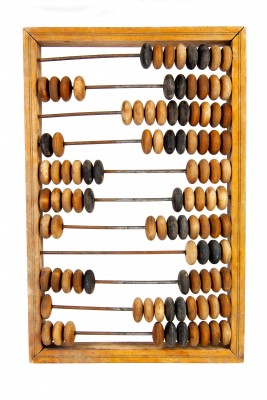The most frequent question I am asked when giving money management advice is “How do I get started saving money?” I’ve learned that the best way to get aspiring savers started is with the wonderfully simply but wonderfully powerful Multiply-by-25 Rule. There is something magical about how this rule helps people quickly learn how to start saving money.
 The power of the Multiply-by-25 Rule is how it gets to the nitty-gritty of what is going on in the money management project. Why is it you want to save? It’s so that your money can start earning money, and thereby a bit of the burden of doing that by going to an office or factory each day can be taken off your shoulders.
The power of the Multiply-by-25 Rule is how it gets to the nitty-gritty of what is going on in the money management project. Why is it you want to save? It’s so that your money can start earning money, and thereby a bit of the burden of doing that by going to an office or factory each day can be taken off your shoulders.
Diminishing Your Reliance On a Paycheck
Since the goal of saving is to have your money earn money, it makes sense to measure your progress as a saver by determining the extent to which your saving efforts are diminishing your reliance on a paycheck to cover the costs of keeping body and soul joined together. The usual way of doing this–assessing how much you need to finance a complete retirement from the world of work–is a depressing and frustrating exercise.
What good does it do you to learn that when you have saved $1 million or $2 million, you will no longer need to work? Telling someone struggling to save her first dollar that she needs to save $1 million or $2 million is like telling her that she needs to learn how to fly to the moon. The goal is so big that it paralyzes rather than encourages. That’s not how to start saving money.
The Passion Saving way to save is to break the saving project into manageable bits, focus on a saving goal that provide the necessary motivation to tackle the first bit, and thereby gain confidence that one really can save and excitement over the benefits that can be earned with effective saving. Forget about determining how much you need to save to finance all your costs of living and enjoy a full retirement from the work force. Figure out instead what you need to put away to build up a savings fund large enough to finance just a single spending category. That’s how to start saving money!
Say that you spend $40 per year on magazine subscriptions. The Multiply-by-25 Rule tells you that it takes a savings fund of $1,000 to finance that spending category for life. $1,000 kicks off enough earnings each year so that you never again need worry about working to pay for magazine subscriptions. That’s on an inflation-adjusted basis. That is, the magazines are paid for and the real value of the $1,000 does not diminish at all over time.

The Multiply-by-25 Rule assumes that you will be able to invest the money saved in an investment that will provide a 4 percent annual real return. If you prefer to go with an assumption that your investments will only earn a 3 percent annual real return, you need to employ instead a Multiply-by-33 Rule. If you think that it is reasonable to assume a 5 percent annual real return, you can use a Multiply-by-20 Rule.
Where the Battle Is Won
Do you see how powerfully motivational this tool can be in showing you how to start saving? It’s easy to multiply by 25. So you can apply the rule each time you ponder a decision to spend money or not. The battle for financial freedom is won not at your kitchen tablewhen you list a series of spending categories and spending allocations into a budget binder, but on the street, when you make decisions whether to buy things or not. The beauty of the Mutliply-by-25 Rule is that it is easy to remember and requires only a simple calculation. You can apply it anytime a thought to spend enters your mind and you want to test your newly found power to save when saving makes sense.
There are only two steps to application of the Multiply-by-25 Rule. One, you need to determine how much an item of spending costs over the course of a year. And, two, you need to multiply by 25 to learn how much money you need to save to create a fund that covers that expense for life.
How much of a fund does it take to cover your Saturday-night movie habit? If it costs you $20 per week to buy tickets and a soda and popcorn for you and a friend, that translates into an annual expense of $1,040. Let’s call it $1,000 for purposes of easy calculation. Multiply by 25, and you know that you need to save $25,000 to cover your movie going expense for life.

Using the Multiply-by-25 Rule regularly gets you thinking about money management in a new way, a way that reveals to you how to start saving the way the world’s most effective savers save. One great thing it does is highlight the key insight that financial freedom is not an all-or-nothing proposition. If you have ever tried to lose 30 pounds in one month, you probably can see why this insight is so important. Life-enhancement goals are achieved by approaching them one step at a time. The Multiply-by-25 Rule shows you how to start saving one step at a time.
A Feeling of Accomplishment
Another benefit of this approach to saving is the encouragement it provides when you achieve the goal of building a fund large enough to finance a single spending category for life. It doesn’t take all that long to save the $1,000 you need to finance your magazine spending for life. But it provides a real feeling of accomplishment to know that you need never again be concerned about going to work to earn money to cover that item of spending.
The Multiply-by-25 Rule helps you learn how to start saving in another way. It helps you see the connection between spending more and being required to work more. Many of us spend as a way of alleviating the frustration we feel from having to do work we don’t really love. That’s a “solution” that makes the problem worse!
The Multiply-by-25 Rule makes the connection between over-consumption and continued paycheck dependencepainfully clear. It’s not too long after you get down to the business of trying to create a $25,000 fund to cover your movie-going expenses that you start wondering whether it might make more sense to go to the movies not once every week but once every two weeks.
The Multiply-by-25 Rule also helps you to learn how to start saving by drawing your attention to the true purpose of saving — winning the financial freedom to live the life you want to live. Most saving advice is aimed at helping you learn to save to finance an old-age retirement. Saving for financial freedom you begin to enjoy earlier in life is far more effective because we all feel more motivated to do things that produce near-term gains. Saving just $1,000 permits you to feel the sweet feeling of financial freedom in a small way. You really need to save only that amount to be free of the need ever again to work to pay for magazines.
Younger Is Better
Yet another way in which the Multiply-by-25 Rule helps you learn how to start saving is by underlining the importance of beginning to save when you are young. It won’t be too long after you begin making use of the rule that it will hit you that you are eventually going to need to build up funds to cover all of your spending categories at some point in life and that it makes sense to get the task out of the way as early in life as possible.

If you have your magazine category savings in place by age 30, that’s when you stop paying for magazines with the work you do. Wait until age 40, and your labor foots the bill for an additional 10 years. Hey! Doesn’t it sound like a good idea to avoid having to pay for magazines for 10 years just by winning your financial freedom for that spending category a bit sooner? That’s how those rare people who somehow knew by themselves how to start saving do things. Now you can too.
 The Multiply-by-25 Rule is a simple rule. But it is the most powerful money management tool that I have discovered in 14 years of studying what it takes to win financial freedom early in life. The best practical advice that I can offer those seeking to learn how to start saving is to start making use of the Multiply-by-25 Rule on a daily basis when faced with decisions as to whether to spend or save money.
The Multiply-by-25 Rule is a simple rule. But it is the most powerful money management tool that I have discovered in 14 years of studying what it takes to win financial freedom early in life. The best practical advice that I can offer those seeking to learn how to start saving is to start making use of the Multiply-by-25 Rule on a daily basis when faced with decisions as to whether to spend or save money.
